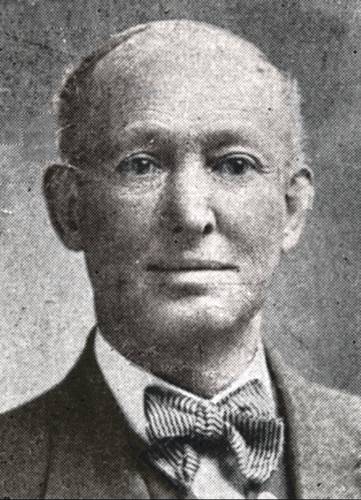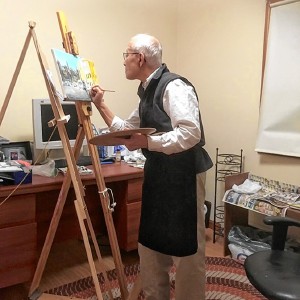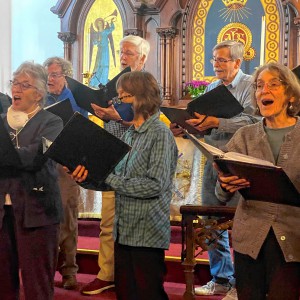Facing history: Wendell Historical Society grapples with some challenging facts of their building’s history

Wallace Goldsmith, Wendell barber and entertainer, built the building that is now becoming the Wendell Historical Society. Contributed
| Published: 03-15-2024 3:27 PM |
With the first anniversary of the Wendell Historical Society approaching on April 1, the Society's President, Edward Hines, went searching for the history of the building that the society calls its home.
Last July, the society purchased the former depot store and post office, located at 466 Wendell Depot Rd., to be used as their museum. With fundraising underway for the repairs of the old building, the historical society went off searching for what they love most: its history.
Hines found in the tax records in Wendell that 466 Wendell Depot Road was built “circa 1900,” but he says he knew he could find more information than that. So, he searched through old newspapers and letters for additional information.
The basement of the building is unusual, and Hines thought it might offer clues to the building’s history. The basement is cement (poured through a wooden structure, with cement seeping through the gaps between the planks). According to Hines, cement basements are not typically seen until after World War I and they are typically made from dry-laid stone.
Hines speculated that the building may have been constructed in 1909, around the same time as the Athol Orange Electric Company, which also had a similar cement basement.
While following this thread, Hines found a a key that unlocked the mystery of the building's construction. He found a letter dated 1933 from a man named Wallace Goldsmith asking someone in town to survey his land. Goldsmith wrote, “Come to the little new house with the barber shop in it right where the old building burned down.”
The burnt-down building the letter referred to was an old dance hall on top of the Putnam store, which could accommodate 300 people. It burned down in 1931.
With this description, Hines knew he had found the person who had built 466 Wendell Depot Road. This discovery prompted Hines to search for the history of Goldsmith.
Article continues after...
Yesterday's Most Read Articles
He found that Goldsmith, born in Medford in 1856, was a performer, comedian and musician. He started touring performing medicine shows, where he would dress up as a Native American and sell snake oil at opera houses across the county. He also worked as a traveling vaudeville performer, likely using racist caricatures in his performances. He often returned to Wendell and the surrounding area, as his family lived there, and the local papers kept up with his activities.
He married a woman 24 years his junior in 1905, and they quickly divorced after a couple of years while on the road.
In 1930, during the Great Depression, he built himself a house in Wendell Depot, currently the historical society, and set up shop as a barber in a separate room.
He lived for many years in Wendell, but in April 1935, he was attacked by an intruder and severely beaten. Goldsmith never recovered and died in October 1939.
Hines found this story interesting and challenging as a historian. As he leads the Wendell Historical Society through its first year, he hopes to understand how to celebrate history while also educating the public on history with a more somber tone.
Hines sees Goldsmith as a challenging character; In Goldsmith’s divorce proceedings, for instance, accusations of drunkenness and abuse surfaced, and Hines speculates that his attack and subsequent death may have been a direct result of his actions.
“It makes me wonder what this man was about. Was he an abuser who reformed himself, or did he live that way for the rest of his life?” Hines said. “This is a complicated man who chose a rough path. He was an entertainer in a style we no longer embrace.”
Wendell has never had a legal historical society before. Hines is excited for this new chapter, where Wendell gets a seat at the table for conversations about New England history.
“I am always hearing people talk about this as a hippie town with tree-hugging environmentalists … there is a lot more,” he said. “We are rediscovering lots of stuff about this town, which makes it as important as any town in Massachusetts. We have not been part of the conversation until now.”
The society hopes to have at least one room of the building open to the public by the end of the year, depending on available grants. They are excited to continue learning from the many stories of Wendell’s history and to be a source of education to the public moving forward.
The Historical Society's version of Goldsmith's story is available on the website www.wendellhistoricalsociety.org/GoldsmithCollection.html.

 Proof that it’s never too late: Solo exhibit and free workshops honor the late Frederick Gao, a Belchertown resident who became a painter in his last five years
Proof that it’s never too late: Solo exhibit and free workshops honor the late Frederick Gao, a Belchertown resident who became a painter in his last five years Self-expression on display: ServiceNet members’ artworks on view at Greenfield Public Library through end of May
Self-expression on display: ServiceNet members’ artworks on view at Greenfield Public Library through end of May Embracing both new and old: Da Camera Singers celebrates 50 years in the best way they know how
Embracing both new and old: Da Camera Singers celebrates 50 years in the best way they know how Time to celebrate kids and books: Mass Kids Lit Fest offers a wealth of programs in Valley during Children’s Book Week
Time to celebrate kids and books: Mass Kids Lit Fest offers a wealth of programs in Valley during Children’s Book Week
